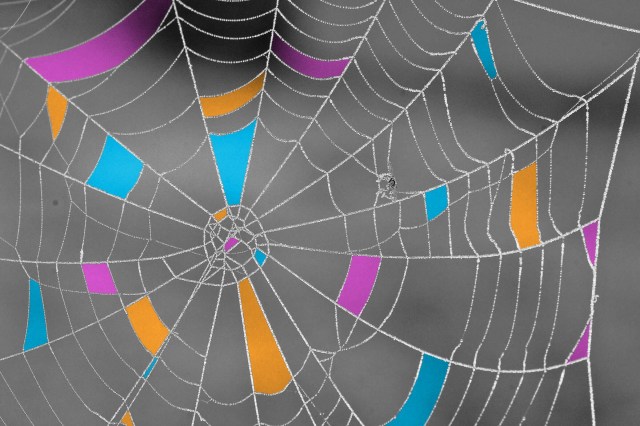
Spiders Have Special Organs to Make Silk for Their Webs
All spiders produce silk, even if most of the world’s roughly 50,000 spider species don’t construct webs. Flexible, durable silk is produced as a liquid protein in organs called spinnerets on the underside of spider abdomens. Each spinneret has at least one spigot that extrudes the protein. When the goo hits the air, it turns into a filament of silk. Many spiders have several kinds of spinnerets, which produce different types of sticky and nonsticky silk.

Spiderwebs Are Extremely Versatile
Think of spiderwebs as tiny nets to catch specific meals. Flying insects get trapped in nearly invisible webs that are oriented vertically, while horizontal webs catch ants, caterpillars, and other non-airborne morsels. Most spider species kill the prey stuck in their webs with a venomous bite. One odd group is an exception: Instead of disabling with venom, spiders in the family Uloboridae wrap their prey in an enormous amount of silk, boa constrictor-style, that eventually crushes it to death. An orb weaver spider named Philoponella vicina has been observed wrapping its victims in more than 260 feet of silk.
Spiders can also use their silk like a lasso to proactively grab a meal, as a parachute to travel through the air, as a temporary shelter during inclement weather, and even as an airtight scuba tank when diving underwater.

Spiderwebs Are Amazingly Strong
Spider silk is often described as being, pound for pound, five times stronger than steel. In a 2018 study in the journal ACS Macro Letters that examined brown recluse spiders’ silk, scientists explained how the tiny threads of a spiderweb achieve their strength: Each strand is made of thousands of even tinier nanofibers stuck together in a ropelike form, making the whole more durable. The nanofibers also make the strands flexible and resistant to breaking. Spiderwebs can absorb the impact of a bug flying into them, for example, by stretching upon initial contact and then strengthening under continued pressure, localizing any damage while preserving the integrity of the web.
More Interesting Reads

Spiderwebs Come in a Variety of Shapes
Spiders in the family Araneidae spin orb webs — the classic spiderweb shape that’s circular and geometrically segmented with spokes radiating from the center. These often span open spaces between tree branches or in the corners of a building. Spiders in the family Linyphiidae build sheet webs horizontally over a patch of grass or foliage; the thickly woven web forms a cover for the spider to hide under while it waits for prey to approach.
Tangle webs (also called cobwebs) are built by spiders that belong to the family Theridiidae, which includes black widows. These webs look like a messy clump of threads supported by a solid base, such as a rock or tree branch. Funnel weaver spiders, in the family Agelenidae, build webs with a large horizontal opening and a tube-shaped funnel in the center or on the side, where the creatures wait for prey to wander by and become stuck in the filaments. Funnel webs are usually found near the ground amid brush or grass.

Designers Have Made Clothes From Spider Silk
People have been trying to adapt light, flexible spider silk for clothing for a long time. In 1709, the French naturalist François Xavier Bon de Saint Hilaire succeeded in making gloves and stockings from spider silk painstakingly collected by boiling egg sacs and teasing out the fibers. In the late 19th century, French Jesuit priest Paul Camboué invented an apparatus to extract silk from golden orb weaver spiders, but his captive arachnids cannibalized each other — a problem that later spider silk farmers also encountered. As a result, spider silk clothing is extremely difficult — but not impossible — to make. Designers Simon Peers and Nicholas Godley, plus a large team of fiber artisans, managed to create a cape and shawl made from golden orb weaver silk and displayed the items in 2012 at London’s Victoria and Albert Museum.
Scientists have also tried to bioengineer spider silk and mimic its strength and beauty. In 2015, The North Face and a materials company called Spiber created the “moon parka,” a jacket with an outer shell of synthetic spider silk manufactured by genetically engineered microbes.

Spiderwebs Can Heal Wounds
If you have a cut on your arm, a spiderweb would probably be the last thing you’d think to put on your skin, but ancient Greeks often placed them over wounds to stop bleeding. The proteins that form silk are high in vitamin K, a coagulant that aids blood clotting. One Roman surgeon also suggested getting rid of a wart by wrapping it in a spiderweb and setting it on fire (don’t try this at home). French soldiers in the 14th-century Battle of Crécy carried spiderwebs in their uniforms to serve as bandages, and Shakespeare later cited the webs’ styptic quality. In A Midsummer Night’s Dream, Bottom says to the fairy Cobweb, “I shall desire you of more acquaintance, good Master Cobweb/If I cut my finger I shall make bold with you.”











